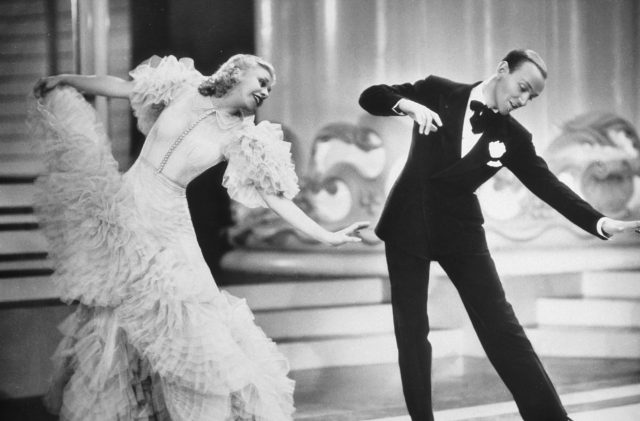TCM Classic Film Festival 2021: Part One, by David Bax

For the second year in a row, there was no in-person TCM Classic Film Festival this spring. No drinks with old friends at the Pig ‘n Whistle, no charming anecdotes from well-seasoned celebrities, no nitrate at the Egyptian. And I am once again not writing this while mooching free wi-fi and free chips and salsa from the bar at Sammy Hagar’s chain Mexican restaurant. I miss all of that but the thing that I miss most is the thing that no other festival has quite like this one; the chance to watch films in a theater full of people who absolutely love movies just as much as you do. I felt the absence of that community vibe acutely during the first film I watched this year, Mark Sandrich’s Top Hat. I love to strike a balance, during TCM Fest, between discovering obscurities and filling in gaping blind spots. Top Hat is the latter, a beloved Astaire and Rogers classic that I probably would have enjoyed more in a room full of acolytes. As it stands, I found it to be a movie with as many peaks (the dance numbers) as valleys (pretty much everything else). Fred Astaire and Ginger Rogers could have spent the entire time sweeping and tangling gracefully around each other in magnificent costumes and I wouldn’t have complained. Even the numbers they’re not in–like a group dance, filmed prominently in a wide shot from above, in which pairs of male and female dancers are each connected at the waist by a long satin sash–are knockouts. But most of the other elements (notwithstanding the lavish production design) seem a bit derivative, with a combative central courtship out of the previous year’s It Happened One Night and wordplay that’s sub-Marx Brothers. Edward Everett Horton as Horace, the theatrical producer who’s hired Astaire’s Jerry Travers, and Helen Broderick as Horace’s wife sell the farce better than anyone else on screen but I still spent most of the time just wondering when people were going to start dancing again.

My first night of TCM Fest (whatever that means; with HBOMax, Watch TCM and good old DVR, scheduling is largely up to the viewer) ended on a much higher note, though. Michael Curtiz’s Doctor X is schlocky fun assembled with undeniable and inspired filmmaking chops. Curtiz does for the mad scientist horror genre the same thing he would do for the murder mystery a year later with The Kennel Murder Case. Namely, he keeps it fast, light, funny and thrillingly engaging. Doctor X is a two-strip Technicolor affair (with all the attendant teals and tangerines) in which the head of a research institute (Lionel Atwill) tries to uncover which, if any, of the eccentric doctors in his employ is behind a series of gruesome murders. Lee Tracy is the wisecracking newspaper reporter who cons his way into the facility to get the scoop; he’s also the main source of the film’s comedy, mugging and gesticulating superstitiously at the macabre, haunted house-type nature of the labyrinthine building. When Tracy’s not tussling with model skeletons in supply closets, Fay Wray owns the picture as the doctor’s self-assured daughter. Wray’s reputation as a “scream queen” was not, to my understanding, established at this time but Doctor X was likely one of the films that solidified it as her vocal chords get quite the workout.

Saturday morning at the festival (my couch) kicked off with 1966’s The Fortune Cookie, a movie most notable for initiating the decades-long cinematic powerhouse pairing of Jack Lemmon and Water Matthau. Other than that, I’m sorry to say, I’d classify it as lesser Billy Wilder. His trademark cynicism is on full display (no complaints from me on that) but with Lemmon as another sad sack (or “born loser,” as he’s called here) living in a crummy apartment and roped into someone else’s immoral scheme (a fraudulent personal injury lawsuit perpetrated by Matthau’s sleazy lawyer), it’s hard not to compare The Fortune Cookie to The Apartment and find it lacking. There’s also some awkward use of swear words (Lemmon’s Harry calls his ex-wife a “bitch” and doesn’t sound comfortable doing it) and some intensely patronizing race issues that come on strong in the final act.

We’ll wrap up this installment with a fascinating rarity, 1951’s The Whistle at Eaton Falls, which, despite the pedigree of director Robert Siodmak (The Killers, Criss Cross), star Lloyd Bridges and a meaty, very early role for Ernest Borgnine, has remained fairly obscure. That’s probably because, as a social issue drama, it would likely sound dry to the uninitiated. Bridges plays Brad Adams, the president of a plastic workers union chapter in small town New England who gets hired to run the very factory where his members work. As the company faces stiff competition from rivals, Brad has to find a way to keep people employed even as they come to see him as a turncoat. As a pro-union movie, The Whistle at Eaton Falls is a little soft, too eager to paint the workers as easily led saps who just need good, compassionate management. And the conflict’s resolution, a sort of deus ex plastica, is a fairytale. But Siodmak’s ability to tease out drama less from the situation but from the people involved–a keen awareness of how interpersonal relationships and economic hardships can push at one another’s boundaries–makes this a gem worth uncovering.





























